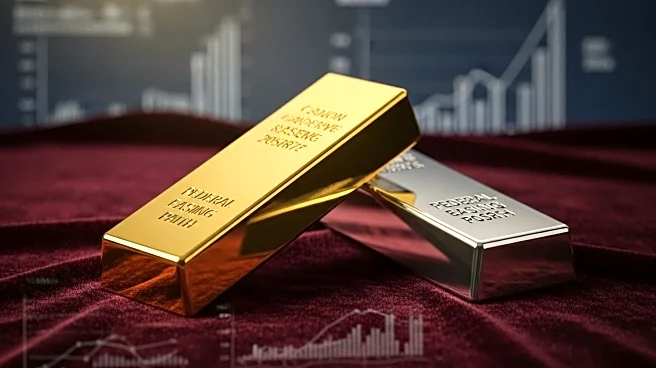What's Happening?
The U.S. Federal Reserve's anticipated shift towards a more accommodative monetary policy has significantly increased demand for precious metals, particularly gold and silver. The August 2025 nonfarm payrolls report showed a disappointing addition of only 22,000 jobs, far below the expected 75,000, prompting speculation of aggressive rate cuts by the Fed to prevent a recession. The unemployment rate has risen to 4.3%, the highest since October 2021, indicating persistent economic fragility. As a result, the CME FedWatch Tool indicates a 99.6% probability of a 25-basis-point rate cut at the upcoming September meeting, with further easing expected in 2025. This has led to a weakening U.S. dollar, with the Dollar Index falling to 98.10, and a surge in gold prices, which have reached near-record highs of $3,600 per ounce. Silver has also seen a 37% increase in prices this year, driven by industrial demand and supply constraints.
Why It's Important?
The Federal Reserve's potential rate cuts and the weakening dollar have significant implications for investors and the broader economy. Gold's rise as a safe-haven asset reflects its role in hedging against macroeconomic risks and dollar depreciation. The increase in gold prices benefits investors seeking stability amid economic uncertainty. Silver's performance highlights its dual role as both an industrial and monetary asset, with its price influenced by supply constraints and demand from sectors like renewable energy. The strategic allocation to precious metals offers investors a way to diversify portfolios and mitigate risks associated with economic volatility. The Fed's policy decisions will continue to shape market dynamics, influencing investment strategies and economic outcomes.
What's Next?
As the Federal Reserve's easing path becomes clearer, investors are likely to continue reallocating assets towards precious metals. Gold's status as a safe-haven asset is expected to remain strong, while silver's price will be influenced by industrial demand and geopolitical factors. The Fed's decisions in the coming months will be closely watched by investors, as further rate cuts could drive additional demand for non-yielding assets like gold and silver. Market participants will need to balance exposure to these metals with potential risks from dollar fluctuations and global trade dynamics.
Beyond the Headlines
The current economic environment underscores the importance of understanding the distinct drivers of gold and silver markets. Gold's inverse relationship with the dollar and its role as a hedge against systemic risks make it a critical component of investment strategies. Silver's sensitivity to industrial demand and trade tensions requires a nuanced approach, balancing its potential for growth with its vulnerability to external shocks. The evolving landscape of monetary policy and global trade will continue to shape the strategic value of precious metals in investment portfolios.













